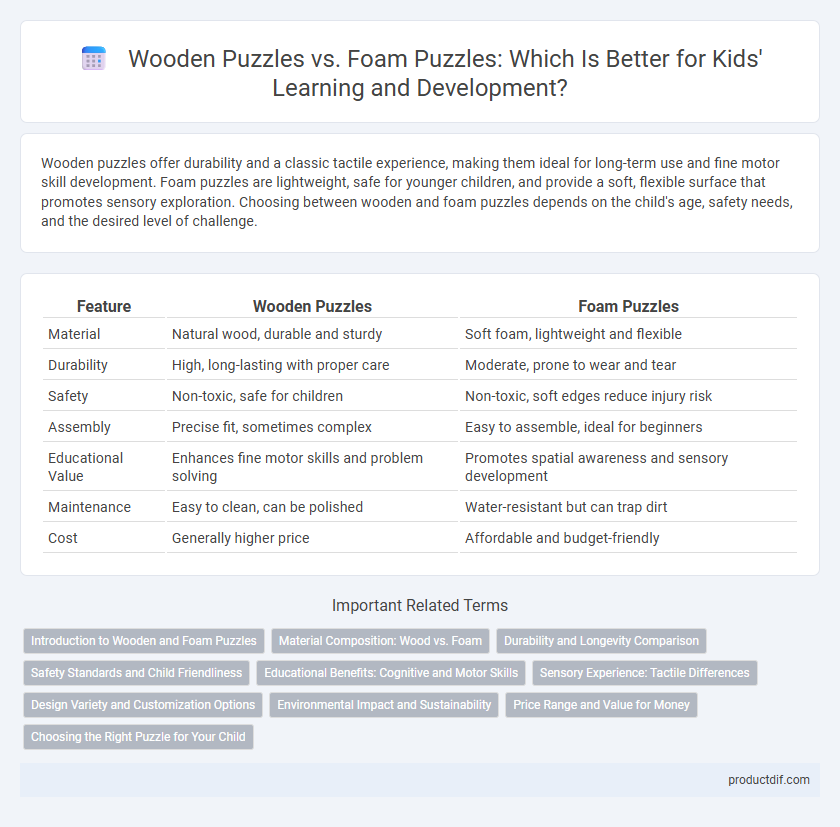Wooden puzzles offer durability and a classic tactile experience, making them ideal for long-term use and fine motor skill development. Foam puzzles are lightweight, safe for younger children, and provide a soft, flexible surface that promotes sensory exploration. Choosing between wooden and foam puzzles depends on the child's age, safety needs, and the desired level of challenge.
Table of Comparison
| Feature | Wooden Puzzles | Foam Puzzles |
|---|---|---|
| Material | Natural wood, durable and sturdy | Soft foam, lightweight and flexible |
| Durability | High, long-lasting with proper care | Moderate, prone to wear and tear |
| Safety | Non-toxic, safe for children | Non-toxic, soft edges reduce injury risk |
| Assembly | Precise fit, sometimes complex | Easy to assemble, ideal for beginners |
| Educational Value | Enhances fine motor skills and problem solving | Promotes spatial awareness and sensory development |
| Maintenance | Easy to clean, can be polished | Water-resistant but can trap dirt |
| Cost | Generally higher price | Affordable and budget-friendly |
Introduction to Wooden and Foam Puzzles
Wooden puzzles offer sturdy, durable pieces made from natural materials, ideal for developing fine motor skills and problem-solving in children. Foam puzzles provide lightweight, soft, and easy-to-handle pieces, often featuring vibrant colors and large shapes suitable for toddlers and sensory play. Both types enhance cognitive abilities but differ in texture, safety, and longevity, catering to various age groups and learning preferences.
Material Composition: Wood vs. Foam
Wooden puzzles are crafted from natural hardwood or plywood, providing durability and a tactile, sturdy feel that withstands frequent handling and offers a classic aesthetic. Foam puzzles utilize lightweight, closed-cell foam, making them soft, flexible, and ideal for young children due to their safety and ease of manipulation. The material composition influences puzzle longevity, texture, and user experience, with wood favoring toughness and firmness while foam prioritizes cushioning and safety.
Durability and Longevity Comparison
Wooden puzzles offer superior durability and longevity compared to foam puzzles due to their solid construction and resistance to wear and tear. Foam puzzles tend to degrade faster, showing signs of bending, tearing, or losing shape, especially with frequent use. Investing in wooden puzzles ensures a longer-lasting, more resilient toy that withstands repeated handling by children.
Safety Standards and Child Friendliness
Wooden puzzles often meet stringent safety standards such as ASTM F963 and EN71, ensuring non-toxic finishes and smooth edges that prevent splinters, making them highly child-friendly. Foam puzzles, typically made from EVA foam, comply with safety regulations for chemical content and are lightweight, soft, and easy for young children to handle without risk of injury. Both options cater to child safety, but wooden puzzles provide durability and tactile engagement, while foam puzzles excel in cushioning and flexibility for toddlers.
Educational Benefits: Cognitive and Motor Skills
Wooden puzzles enhance fine motor skills and spatial reasoning by requiring precise hand-eye coordination and problem-solving strategies. Foam puzzles support sensory development and tactile learning, making them ideal for younger children building basic motor skills. Both types improve cognitive abilities, with wooden puzzles fostering complex thinking and foam puzzles encouraging sensory exploration.
Sensory Experience: Tactile Differences
Wooden puzzles offer a solid, smooth texture that provides a satisfying, tactile feedback with each piece fit, enhancing fine motor skills and hand-eye coordination. Foam puzzles feature a lightweight, soft, and slightly spongy feel that cushions hands and makes manipulation easier for younger children or those with sensory sensitivities. The tactile differences between wooden and foam puzzles significantly impact sensory engagement and suitability for various developmental needs.
Design Variety and Customization Options
Wooden puzzles offer a wide range of intricate designs, often featuring handcrafted, detailed artwork that appeals to collectors and enthusiasts. Foam puzzles provide greater customization options with vibrant colors and thematic shapes suitable for younger children and educational purposes. Both types cater to different preferences, with wooden puzzles emphasizing craftsmanship and foam puzzles excelling in versatility and personalization.
Environmental Impact and Sustainability
Wooden puzzles have a lower environmental impact due to the use of natural, biodegradable materials sourced from sustainably managed forests, reducing plastic waste and promoting renewable resources. Foam puzzles, typically made from non-biodegradable synthetic materials, contribute to plastic pollution and have a longer decomposition period, negatively affecting ecosystems. Choosing wooden puzzles supports sustainable practices and minimizes environmental damage compared to foam puzzles.
Price Range and Value for Money
Wooden puzzles typically range from $15 to $50 depending on craftsmanship and piece count, offering durable, eco-friendly materials that justify their higher price. Foam puzzles are often priced between $5 and $20, providing lightweight and inexpensive options ideal for younger children but with less longevity. For value-conscious buyers, wooden puzzles present a long-term investment with robust quality, while foam puzzles deliver immediate affordability and ease of use.
Choosing the Right Puzzle for Your Child
Wooden puzzles offer durability and tactile engagement, making them ideal for young children who benefit from sturdy, easy-to-handle pieces that promote fine motor skills and cognitive development. Foam puzzles provide lightweight, colorful, and safe options with interlocking pieces suitable for toddlers who require soft materials to prevent injury. Choosing the right puzzle depends on your child's age, skill level, and sensory preferences, ensuring an enjoyable and educational play experience.
Wooden puzzles vs foam puzzles Infographic

 productdif.com
productdif.com